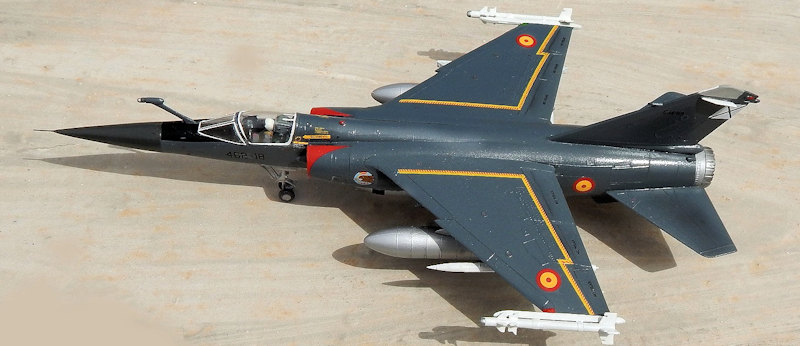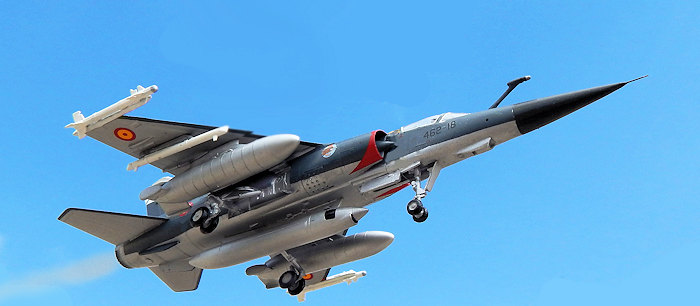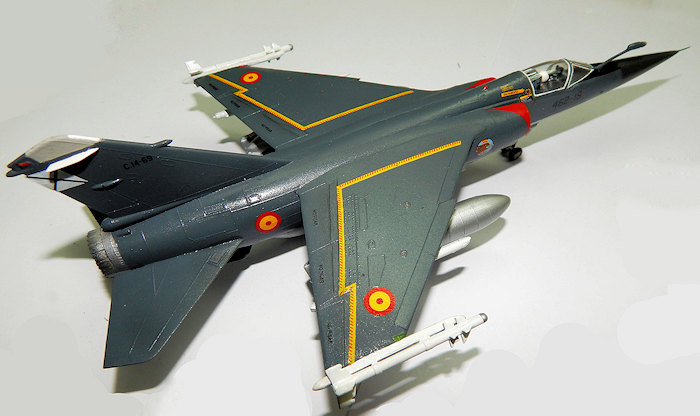
| KIT #: | 258 |
| PRICE: | $ |
| DECALS: | Five options |
| REVIEWER: | Carmel J. Attard |
| NOTES: |

| HISTORY |
Initial Model for Armee de l’Air intended primarily for high-altitude
interceptor role. Versions include F1A, interceptor, the F1C, the F1E M-53
powered multi-role version, and the F1R reconnaissance model, Fifteen Mirages F1
have been ordered initially by Spain which had options for more. Other countries
included G reece,
South Africa, and was also exported further afield to South Africa, Ecuador,
Morocco, Libya, Iran, Iraq, Jordan, Qatar and Kuwait
reece,
South Africa, and was also exported further afield to South Africa, Ecuador,
Morocco, Libya, Iran, Iraq, Jordan, Qatar and Kuwait
In all, Spain has acquired 91 Mirage F1. 73 units initially purchased (45 F1 CE, 22 F1 EE and 6 F1 BE) plus 5 second hand units purchased from France and 13 second hand units also purchased to Qatar, Mid-’90s, 51 single-seaters and 4 double-seaters were upgraded to F1 M version. They had a number of improvements including intelligent 26″ HUDs with integrated radar, HOTAS system, and modernized Cyrano IVM radar for accurate ground-attack capability in four different modes, Night Vision Goggles compatibility, and inertial navigator Sagem ULISS 47.
| THE KIT |
 The
kit that goes back over 40 years when it was originally released as F1C fighter
version with extra parts needed for the two seater version. The kit was later
released as a F1CR and even today the end result would complement the type that
was once France’s tactical fighter. The kit is molded in dark green styrene,
around 75 parts in all enabling it to be made in the single seat or two-seat
version with markings for five, F1C French Air Force and a Greek Air Force F1C.
Parts include 25 under wing and fuselage stores with four combinations.
The
kit that goes back over 40 years when it was originally released as F1C fighter
version with extra parts needed for the two seater version. The kit was later
released as a F1CR and even today the end result would complement the type that
was once France’s tactical fighter. The kit is molded in dark green styrene,
around 75 parts in all enabling it to be made in the single seat or two-seat
version with markings for five, F1C French Air Force and a Greek Air Force F1C.
Parts include 25 under wing and fuselage stores with four combinations.
| CONSTRUCTION |
The nose section forward of the intake is assembled separately from main fuselage so that a layout for an F1C differed from that of the F1B. This makes use of a separate spine provided and that would need some care to be flush fitted with the remainder of fuselage halves. There is good inscribed detail and fit of parts is reasonable. The method of assembly sequence requires some care in certain areas. The tail unit is separate from the fuselage halves and one has to ensure that it is set in vertical position.
 The cockpit
instrument panel is carefully hand painted as also is the interior sides and I
incorporated an ejection seat which came from Pavla set C 72094 for the F1CT
which is much more detailed than the one provided with the kit and fits inside
the bath tab kit part 5. The fuselage halves are then mated together with some
care. The engine outlet part is then inserted at the rear of fuselage. Lead
weight added to nose cone before this was glued in place.
The cockpit
instrument panel is carefully hand painted as also is the interior sides and I
incorporated an ejection seat which came from Pavla set C 72094 for the F1CT
which is much more detailed than the one provided with the kit and fits inside
the bath tab kit part 5. The fuselage halves are then mated together with some
care. The engine outlet part is then inserted at the rear of fuselage. Lead
weight added to nose cone before this was glued in place.
The undercarriage is very complex and requires careful assembly to get to correct angles. While the nose gear consists of 5 items that of the main gears contains eight components each. A scrap side and front view is provided for reference with the hope of aiding assembly of the main gear. Once these legs are built up they are added to the fuselage. There is plenty of wheel wells detail, which repays careful painting. All the door parts are then added to the fuselage.
 I decided to
add a refuelling probe that I made from a stem; shaped from plastic card and the
FR probe at the tip of it adopted from a small piece of stretch sprue. This was
in fact carried by later series of which Spain also had the type. I also added
an under-nose bulge that carried optical sensors and two under wing long-range
ferry tanks adjusting the shape of the wing pylons provided to look more like
that these should be. With the hope of making my version as a reconnaissance
type I also added a camera carrying fuselage pod which also has a small intake
under its snout, the type of which is found on French machines, and also added a
self protection podded jammer to an under wing outer pylon and an ECM pod on the
opposite outer pylon, commonly seen on Spanish F1s. A pair of Magic wing tip
mounted missiles was also added for self-defence.
I decided to
add a refuelling probe that I made from a stem; shaped from plastic card and the
FR probe at the tip of it adopted from a small piece of stretch sprue. This was
in fact carried by later series of which Spain also had the type. I also added
an under-nose bulge that carried optical sensors and two under wing long-range
ferry tanks adjusting the shape of the wing pylons provided to look more like
that these should be. With the hope of making my version as a reconnaissance
type I also added a camera carrying fuselage pod which also has a small intake
under its snout, the type of which is found on French machines, and also added a
self protection podded jammer to an under wing outer pylon and an ECM pod on the
opposite outer pylon, commonly seen on Spanish F1s. A pair of Magic wing tip
mounted missiles was also added for self-defence.
| COLORS & MARKINGS |
The Mirage is finished in Compucolor French blue grey upper surfaces and aluminium under sides. Frpm my spares box I had markings for a Spanish AF Mirage F1 of the Matricula Militar C.14-69 of 462 Escuadron ‘Halcones’ Ganado Air Base, Gran Canaria, the Canary Islands, Spanish Air Force 1968. These blended nicely on Future coated base. The kit was finally given an overall coat of Micro satin finish.
| CONCLUSIONS |
With a little care, a little effort and some extra work the kit is completed into a version ready to conduct recce missions. The end result captures the graceful lines of this classic aircraft that once could be spotted in the skies of four quarters of the world.
April 2016
Copyright ModelingMadness.com
If you would like your product reviewed fairly and fairly quickly, please contact the editor or see other details in the Note to Contributors.